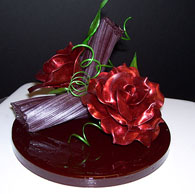Pastillage
Pastillage is porous and dries more rigid and faster than the other edible modelling options. Many people confuse pastillage with gum paste but the real difference is that gum paste contains gum tragacanth to keep it flexible a little longer.
With pastillage, you must work very quickly but the end result is the most sturdy of the sugarcraft mediums. It dries the most rigid of all. It will also take on the least amount of humidity from surrounding features (such as buttercream.)
Gum Paste is basically pastillage with gum tragacanth added, allowing more time to work before the creation hardens. It dries fairly rigid (less than pastillage but far more than fondant.)
Gum Paste dough is very soft and elastic (far more so than pastillage.) It can be rolled out very thin while pastillage cannot.
Fondant
Fondant is tastier and softer than the other edible clays. It holds its shape well, but will never harden completely. It remains maleable much longer than its counterparts and hardens only to a soft clay consistency.
Fondant is tastier and softer than the other edible clays. It holds its shape well, but will never harden completely. It remains maleable much longer than its counterparts and hardens only to a soft clay consistency.
fondant CAN be used to make flowers, bows, and even intricate figures, but they do not dry quite as hard or sturdy as gum paste and they lack the finesse and delicacy you can achieve with gumpaste. You can make your fondant act more like gumpaste by kneeding in about a cup of gum paste mix into a pound of rolled fondant. This will make it dry harder than it normally would. |
Most professional bakers use fondant for covering cakes and making large decorations that will be eaten, and use gum paste for smaller, more intricate decorations. Fondant is found in the center of many candies, like chocolate buttercream-filled candy or the white part of a chocolate-covered cherry (a reaction with the cherry causes the fondant to liquefy a bit, making it runny.)
Sugar PasteSugar Paste is usually assumed to mean gum paste, but there are certainly people who use the term to mean fondant. Since gum paste and fondant have such striking differences, it's best to use these terms to avoid confusion.
Marzipan
Marzipan is a sweet paste made from ground almonds that makes a smooth frosting or decadent filling. Marzipan is pricier than the other edible clays on this page and is considered the tastiest of all. It's considered best for modeling shapes such as fruits and figures for candies and yummy, edible cake decorations.
The figures in the White House Gingerbread House are done with Marzipan because it is so easy to use and the results are very predictable.
Marzipan is frequently used to cover cakes (for its tastiness) along with a layer of fondant (for its smoothness and crisp, bright white color which is easy to turn into any color you desire) or a layer of chocolate. Marzipan is more porous than fondant or chocolate so it would be likely to dry out and become crusty if not covered with another material.
You can dye marzipan in batches or hand-paint the end result shapes (with food dyes of course.) Since it does not start out bright white, like fondant or gum paste, it does not take color quite as easily as the others.
Pulled, Blown & Cast Sugar
Cast, pulled, spun, poured, and blown sugar are the trickiest of the professional pastry chef techniques for intricate decorations. The process involves boiling a mixture of sugar, water, glucose, and cream of tartar, pouring it out onto a greased slab to cool slightly, and then pulling it out to form a glossy sheen. A heat lamp is used to keep the sugar flexible while working with it.
Pouring sugar is the same except that it's poured straight out of the pan into molds. You can purchase molds or cast your own out of plasticene, which is found in most hobby stores.
| Blown sugar is similar except that a small tube is used to blow bubbles into the hot sugar mixture, very similar to glass blowing. Sugar sculptures made with these techniques are quite impressive. Give it a try if you consider yourself more advanced, but be aware that it's common for newbies to burn themselves working with the hot sugar. Most gingerbread house decorations can be formed much more easily with the other techniques listed here. |
http://www.gingerbread-house-heaven.com/edible-clay.html






0 comments:
Post a Comment